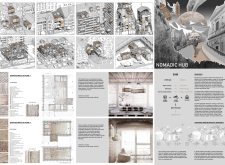5 key facts about this project
The design serves multiple functions, catering to [specific uses such as residential, educational, or mixed-use functions]. This multifunctionality is achieved through a well-considered spatial organization that prioritizes user experience and accessibility. The open-plan layout allows for fluid movement through various spaces, encouraging interaction and fostering a sense of community. Natural light plays a pivotal role in the architecture; strategically placed windows and openings not only illuminate the interiors but also connect occupants with the external environment, blurring the boundaries between inside and out.
Key components of the project include a carefully crafted façade that utilizes a combination of materials. Concrete and glass feature prominently, providing structural stability and transparency, respectively. The use of timber accents enhances the warmth of the design, creating inviting spaces that resonate with users. Steel elements contribute to the overall stability while allowing for innovative structures that support the architectural vision. Additionally, natural stone is thoughtfully integrated into the landscaping and interior features, reinforcing a connection to the regional context.
One of the unique design approaches taken in this project is its emphasis on sustainability. The incorporation of green roofs, solar panels, and rainwater harvesting systems reflects a deep understanding of environmental responsibility. These features are not merely functional; they are integral to the building's aesthetic identity, showcasing a commitment to the ecological impact of architectural design. Furthermore, the landscaping surrounding the project has been designed to enhance biodiversity, encouraging native flora that supports local wildlife.
The architectural ideas presented in this project extend beyond mere aesthetics. They emphasize a dialogue with the local culture and environment, ensuring that the building contributes to its neighborhood rather than dominating it. Thoughtful landscaping elements, public spaces, and community gathering areas enrich the user experience and support civic engagement. Each detail of the design has been carefully considered to enhance usability while reflecting the community’s values.
In summary, this architectural project delivers a compelling narrative through its thoughtful blend of function, sustainability, and context-aware design. The end result is a space that serves not just as a building, but as a catalyst for community interaction and environmental conscientiousness. Those interested in gaining deeper insights into the architectural plans, sections, and design strategies should explore the complete project presentation for further details.























